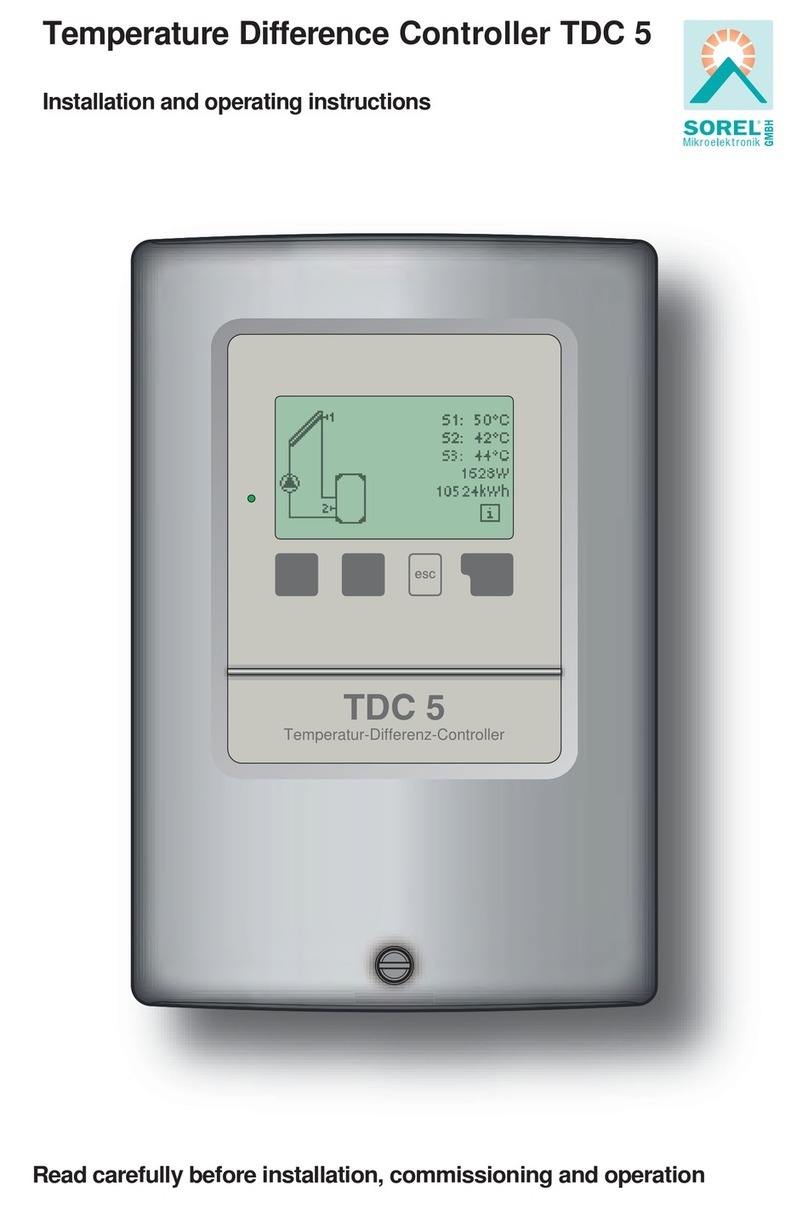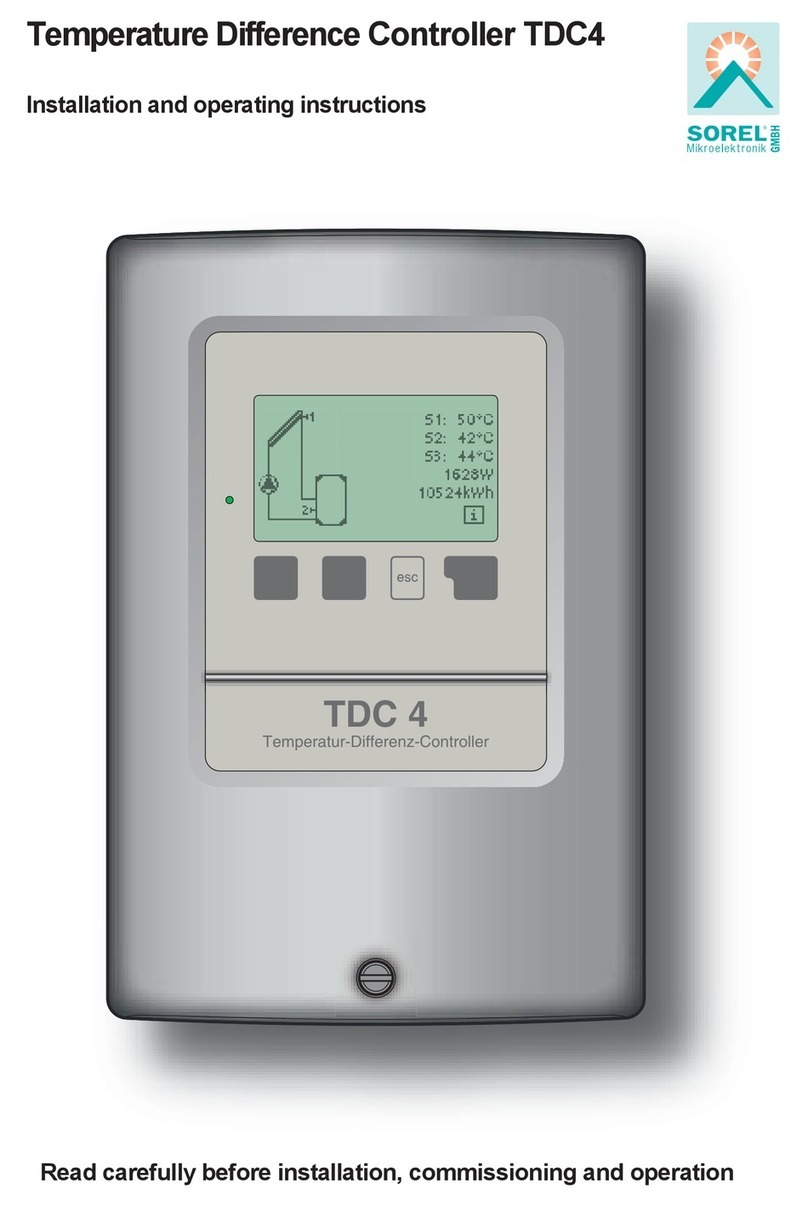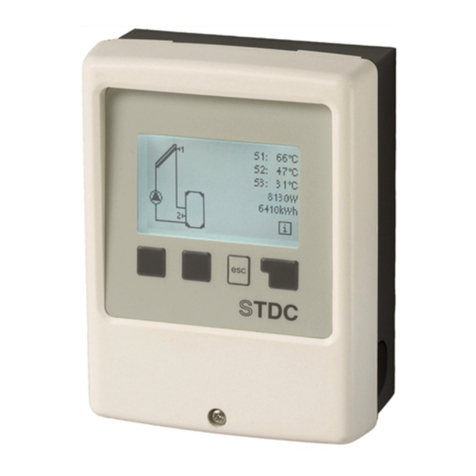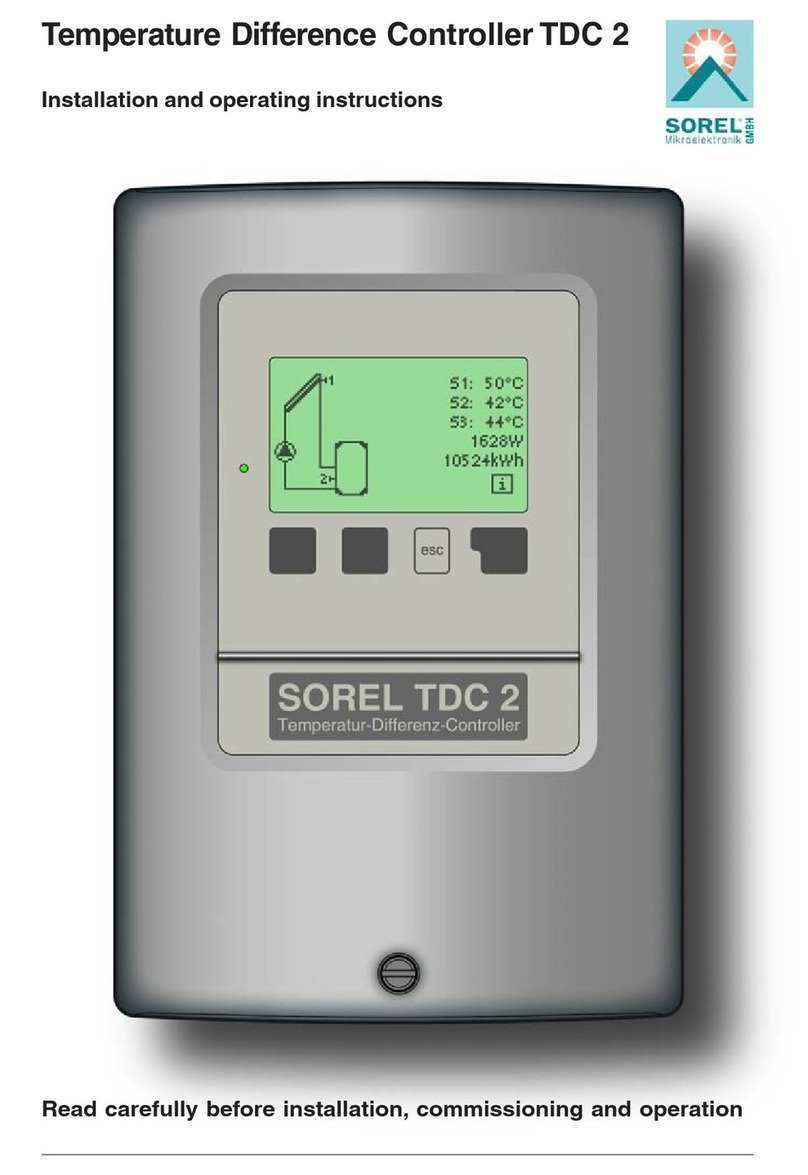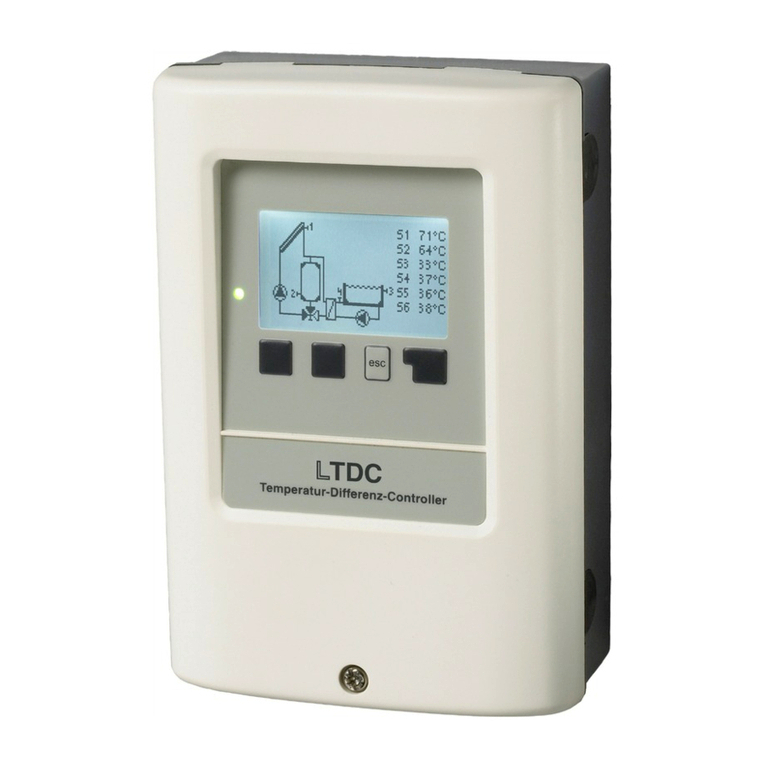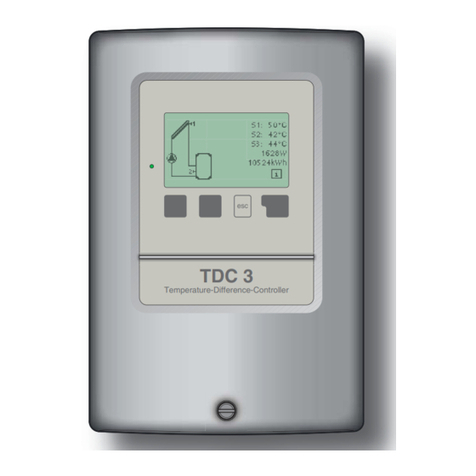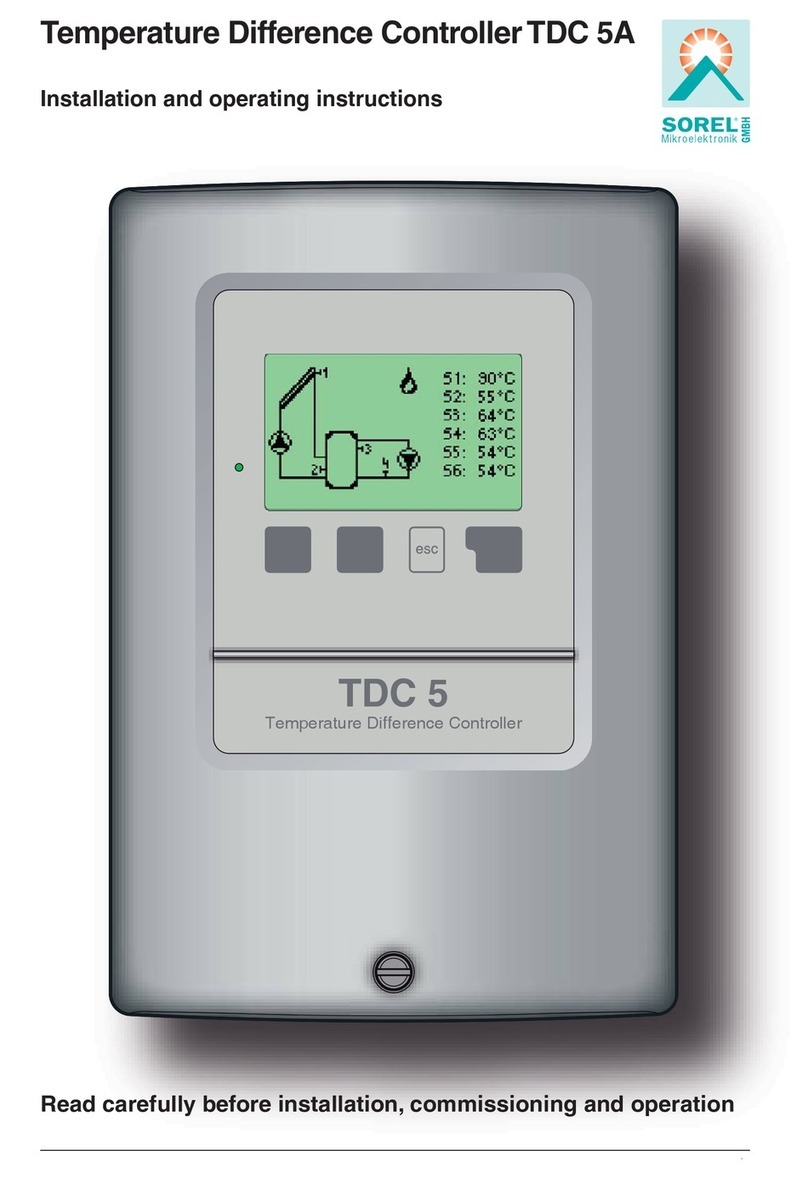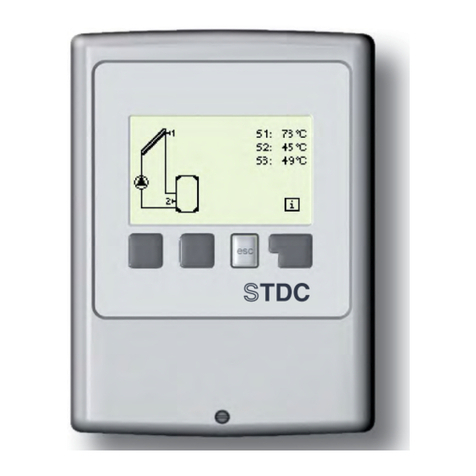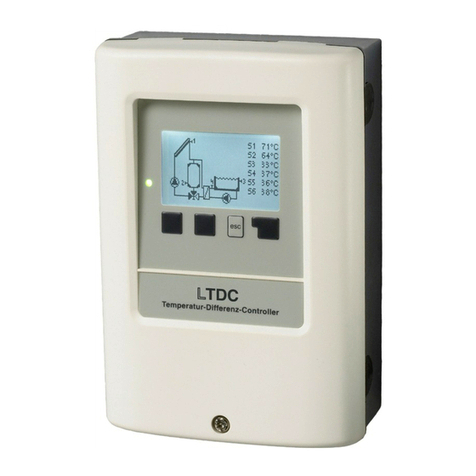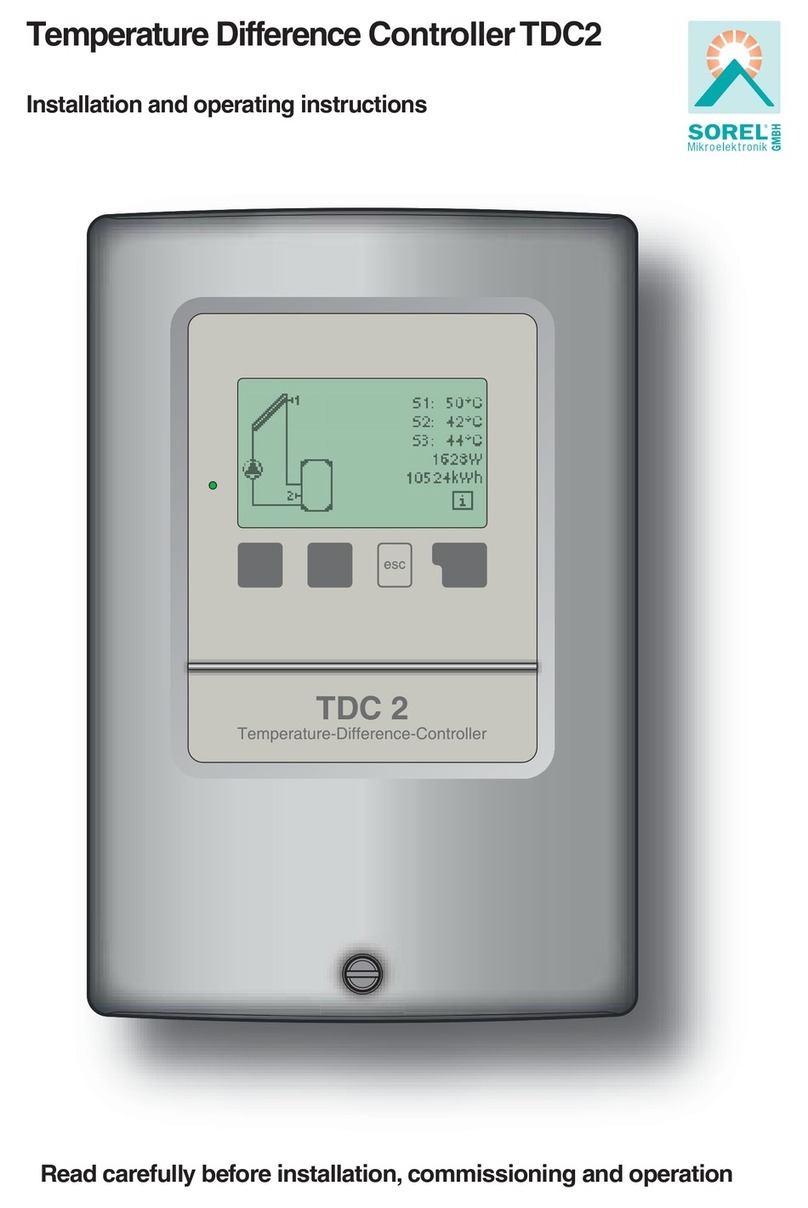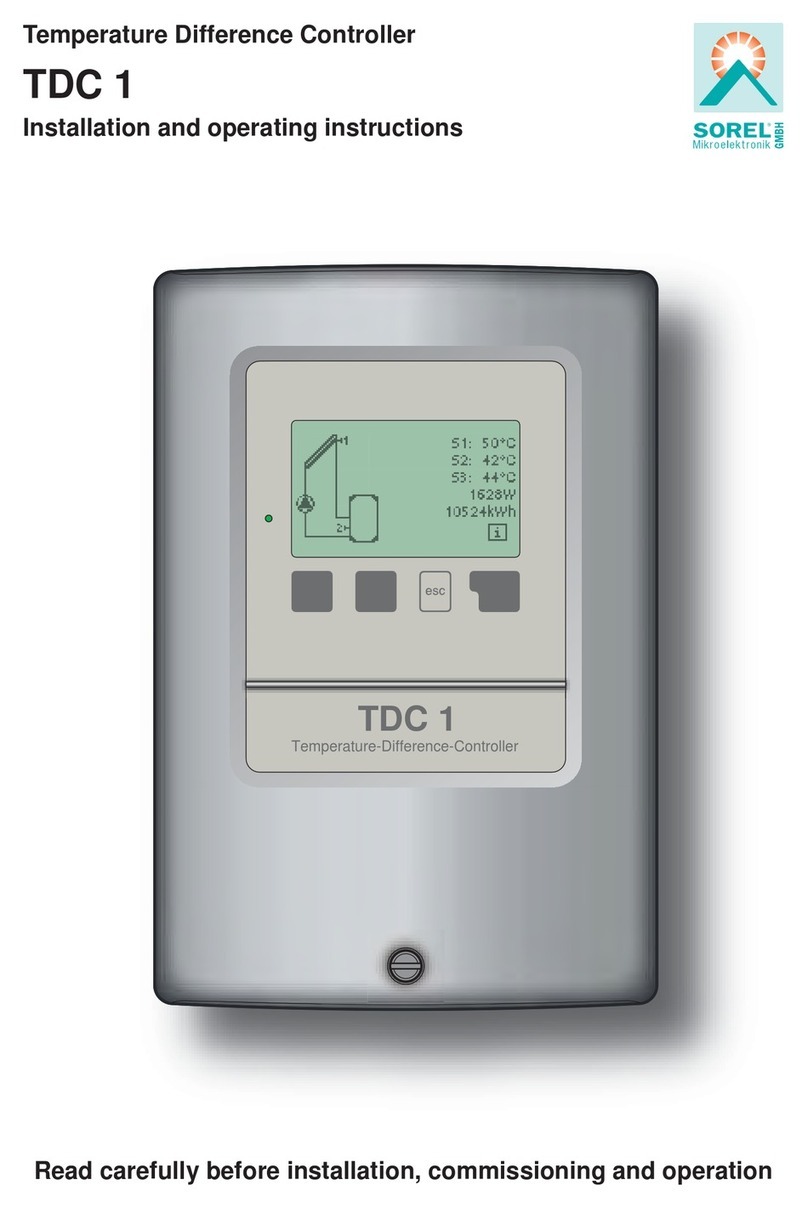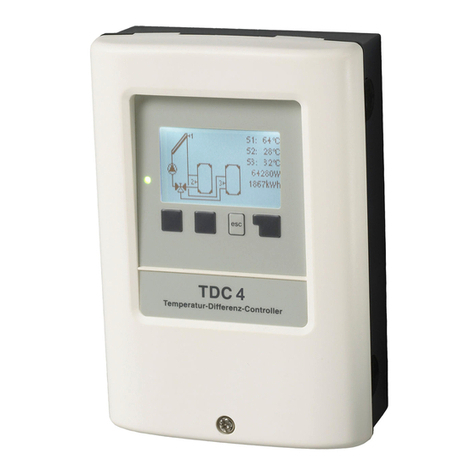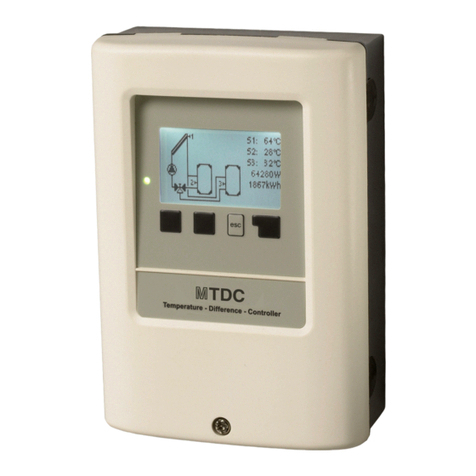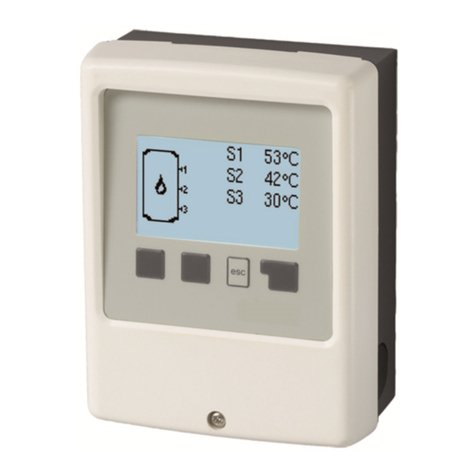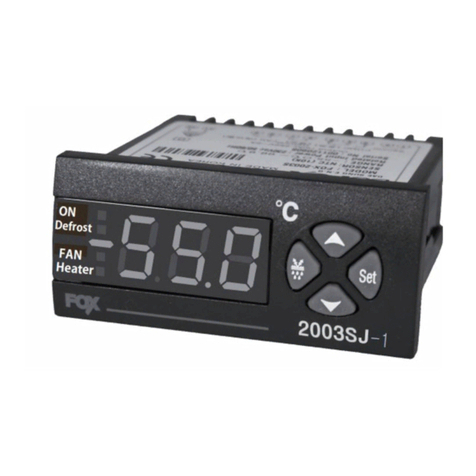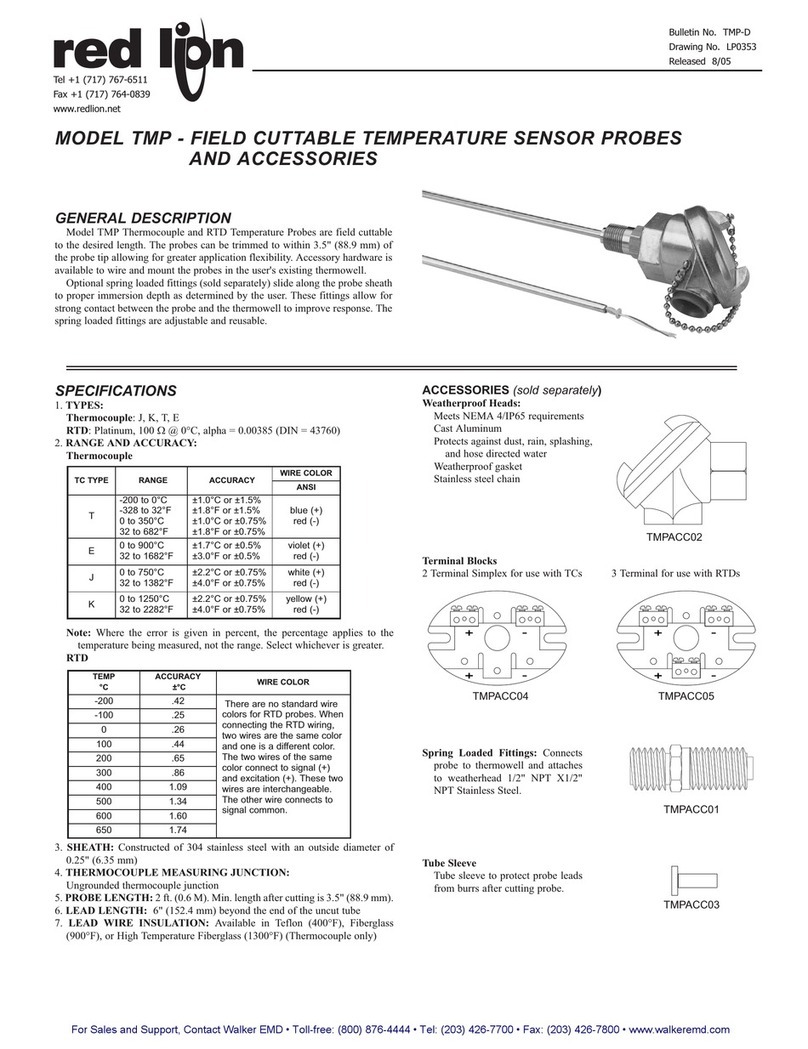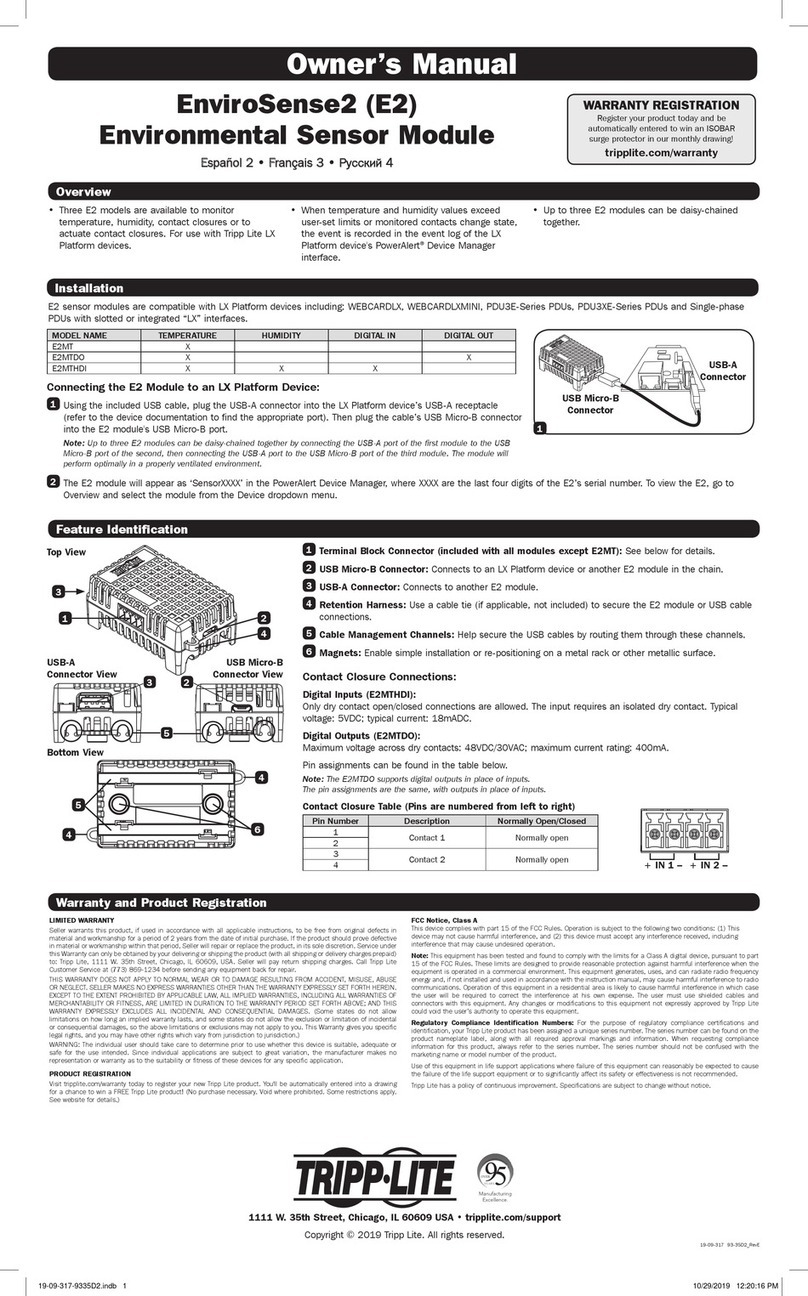Sorel TDC 3 User manual

TDC 3
Temperature-Difference-Controller
Temperature Difference Controller TDC 3
Installation and operating instructions
115V Version
Read carefully before installation, commissioning and operation

Contents
Safety instructions
1.1 EC conformity
1.2 General instructions
1.3 Explanation of symbols
1.4 Changes
1.5 Warranty
1
3
3
3
4
4
Description of controller
2.1 Specifications
2.2 About the controller
2.3 Scope of supply
2.4 Disposal of pollutants
2.5 Hydraulic variants
2
5
6
6
6
7
Operation
4.1 Display and input
4.2. Menu sequence
4
18
19
Parametrisation
5.1 Commissioning help
5.2 Free commissioning
5
20
20
Measurement menu 1
values
621
Analyses menu 2
7.1 Operating hours
7.2 Average ∆T
7.3 Heat output
7.4 Graphic overview
7.5 Error messages
7.6 Reset/clear
7
22
22
22
22
22
22
Display mode menu 3
8.1 Schematic
8.2 Overview
8.3 Alternating
8.4 Temperature Unit
8
23
23
23
23
Menu lock menu 8
13 38
Language menu10
14 38
Malfunctions/maintenance
16.1 Error messages
16.2 Replacing the fuse
16.3 Maintenance
16
40
41
41
Installation
3.1 Wall installation
3.2 Electrical connection
3.3 Installing the sensors
3
8
9-17
17
30
30
31
32
32
Special functions menu 7
12.1 Program selection
12.2 Time & date
12.3 Sensor calibration
12.4 Commissioning
12.5 Factory settings
12.6 Expansions
12.7 Heat metering
12.8 Start aid
12.9 Speed control
12
33
33
33
34
34
34
34
35
36-37
Settings menu 5
10.1-10.3 Tmin...
10.4-10.5 Tmax...
10.6-10.7 ∆T...
10.8-10.9 Tsetpoint,
hysteresis
10.10-10.13 Priority....
10.14 Table/overview
10
25
26
26-27
27
28
29
Useful notes
17 42-43
Operating modes menu 4
9.1 Automatic
9.2 Manual
9.3 Off
9
24
24
24
Service values menu 9
15 39
Chapter
Protective functions menu 6
11.1 Seizing protection
11.2 Frost protection
11.3 Solar protection
11.4 Recooling
11.5 Anti-Legionella
11
ChapterPage Page

3
1.1 EC declaration of conformity
By affixing the CE mark to the unit the manufacturer declares that the Temperature-
Difference-Controller 3, hereinafter refererred to as TDC 3 , conforms to the
following relevant safety regulations:
- EC low voltage directive
73/23/EEC, as amended by 93/68/EEC
- EC electromagnetic compatibility directive
89/336/EEC version 92/31/EEC version 93/68/EEC
Conformity has been verified and the corresponding documentation and the EC
declaration of conformity are kept on file by the manufacturer.
1.2 General instructionsIt is essential that you read this!
These installation and operating instructions contain basic instructions and impor-
tant information regarding safety, installation, commissioning, maintenance and
the optimal use of the unit. Therefore these instructions must be read completely
and understood by the installation technician/specialist and by the system user
before installation, commissioning and operation of the unit.
The valid accident prevention regulations, VDE regulations, the regulations
of the local power utility, the applicable DIN-EN standards and the installation
and operating instruction of the additional system components must also be
observed. The controller does not under any circumstances replace any safety
devices to be provided by the customer!
Installation, electrical connection, commissioning and maintenance of the unit
may only be carried out by specialists who possess the appropriate training.
For the user: Make sure that the specialist gives you detailed information on
the function and operation of the controller. Always keep these instructions in
the vicinity of the controller.
1.3 Explanation of symbols
Failure to observe these instructions can result in danger to life from
electric voltage.
Danger
Danger
Failure to observe these instructions can result in serious damage to
health such as scalding, or even life-threatening injuries.
Caution
Failure to observe these instructions can result in destruction of the
unit or the system, or damage to the environment.
Caution
Information which is especially important for the function and optimal
use of the unit and the system.
Safety instructions
1 1

4
Safety instructions
1 1
1.4 Changes to the unit
1.5 Warranty and liability
The controller has been manufactured and tested with regard to high quality
and safety requirements. The unit is subject to the statutory guarantee period of
two years from the date of sale.
The warranty and liability shall not include, however, any injury to persons or
material damage that is attributable to one or more of the following causes:
- Failure to observe these installation and operating instructions
- Improper installation, commissioning, maintenance and operation
- Improperly executed repairs
- Unauthorised structural changes to the unit
- Installation of additional components that have not been tested
together with the unit
- Any damage resulting from continued use of the unit despite an
obvious defect
- Failure to use original spare parts and accessories
- Use of the device for other than its intended purpose
- Operation above or below the limit values listed in the specifications
- Force majeure
- Changes, additions to or conversion of the unit are not permitted
without the written permission from the manufacturer
- It is likewise forbidden to install additional components that have not
been tested together with the unit
- If it becomes clear that safe operation of the unit is no longer possible,
for example because of damage to the housing, then turn the controller
off immediately
- Any parts of the unit or accessories that are not in perfect condition
must be exchanged immediately
- Use only original spare parts and accessories from the manufacturer.
- Markings made on the unit at the factory must not be altered,
removed or made illegible
- Only the settings actually described in these instructions may be made
on the controller
Danger
Changes to the unit can compromise the safety and function of the unit
or the entire system.

5
Description of controller
2 2
2.1 Specifications
Electrical specifications:
Mains voltage 115VAC +/- 10%
Mains frequency 50...60Hz
Power consumption 2VA
Switched power
Electronic relay R1 min.20W...max.120W for AC3
Mechanical relay R2 460VA for AC1 / 185W for AC3
Internal fuse 2A slow-blow 250V
Protection category IP40
Protection class II
Sensor inputs 3 x Pt1000
Measuring range -40°C up to 300°C
Permissible ambient conditions:
Ambient temperature
for controller operation 0°C...40°C
for transport/storage 0°C...60°C
Air humidity
for controller operation max. 85% rel. humidity at 25°C
for transport/storage no moisture condensation permitted
Other specifications and dimensions
Housing design 2-part, ABS plastic
Installation methods Wall installation, optionally panel installation
Overall dimensions 163mm x 110mm x 52mm
Aperture installation
dimensions 157mm x 106mm x 31mm
Display Fully graphical display, 128 x 64 dots
Light diode Multicolour
Operation 4 entry keys
Temperature sensors: (may not be included in the scope of supply)
Collector or boiler sensor Pt1000, e.g. immersion sensor TT/S2 up to 180°C
Storage tank sensor Pt1000, e.g. immersion sensor TT/P4 up to 95°C
Pipe-mounted sensor Pt1000, e.g. pipe-mounted sensor TR/P4 up to 95°C
Sensor leads 2x0.75mm² extendable up to 30m max.
Temperature resistance table for Pt1000 sensors
°C 0 102030405060708090100
Ω1000 1039 1077 1116 1155 1194 1232 1270 1308 1347 1385

6
2.2 About the controller
The Temperature Difference Controller TDC 3 facilitates efficient use and function
control of your solar or heating system. The device is impressive most of all for
its functionality and simple, almost self-explanatory operation. For each step in
the input process the individual entry keys are assigned to appropriate functions
and explained. The controller menu contains headwords for the measured values
and settings, as well as help texts or clearly-structured graphics.
The TDC 3 can be used as a temperature difference controller for the various
system variants illustrated and explained under 2.5.
Important characteristics of the TDC 3:
- Depiction of graphics and texts in a lighted display
- Simple viewing of the current measurement values
- Analysis and monitoring of the system by means of statistical graphics,etc.
- Extensive setting menus with explanations
- Menu block can be activated to prevent unintentional setting changes
- Resetting to previously selected values or factory settings
- A wide range of additional functions are available.
Description of controller
2 2
2.3 Scope of supply
- Temperature Difference Controller TDC 3
- 3 screws 3,5x35mm and 3 plugs 6mm for wall installation
- 6 strain relief clips with 12 screws, replacement fuse 2A slow-blow
- Installation and operating instructions TDC 3
Optionally contained depending on design/order:
- 2-3 PT1000 temperature sensors and immersion sleeves
Additionally available:
- Pt1000 temperature sensor, immersion sleeves, overvoltage protection,
- Various additional functions by means of supplementary circuit boards
2.4 Disposal and pollutants
The unit conforms to the European RoHS directive 2002/95/EC for the restriction
of the use of certain hazardous substances in electrical and electronic equipment.
Caution
The unit must not under any circumstances be disposed of with ordinary
household refuse. Dispose of the unit only at appropriate collection
points or ship it back to the seller or manufacturer.

7
Description of controller
2 2
2.5 Hydraulic variants
The following illustrations should be viewed only as schematic dia-
grams showing the respective hydraulic systems, and do not claim
to be complete. The controller does not replace safety devices under
any circumstances.
Depending on the specific application, additional system components and safety
components may be mandatory, such as check valves, non-return valves, safety
temperature limiters, scalding protectors, etc., and must therefore be provided.
Caution
13
5
2
4
7
10
13
6
8 9
11 12
14 (∆T controller) 15 (2x∆T controller)
∆T2x∆T

8
3.1 Wall installation
Installation
3 3
Caution
Install the controller only in dry areas and under the ambient conditions
described under 2.1 “Specifications”. Carry out the following steps 1-8.
Fig. 3.1.1
Fig. 3.1.2
1.Unscrew cover screw completely
2.Carefully pull upper part of housing
from lower part.
3.Set upper part of housing aside,
being sure not to touch the electronics
when doing so.
4.Hold the lower part of the housing
up to the selected position and mark
the 3 mounting holes. Make sure that
the wall surface is as even as possible
so that the housing does not become
distorted when it is screwed on.
5.Using a drill and size 6 bit, drill 3
holes at the points marked on the wall
and push in the plugs.
6.Insert the upper screw and screw it
in slightly.
7.Fit the upper part of the housing
and insert the other two screws.
8. Align the housing and tighten the
three screws.

9
Installation
3 3
3.2 Electrical connection
Before working on the unit, switch off the power supply and secure it
against being switched on again! Check for the absence of power!
Electrical connections may only be made by a specialist and in comp-
liance with the applicable regulations.
Do not use the controller if the housing shows visible damage.
Caution
Danger
Low-voltage cables such as temperature sensor cables must be routed
separately from mains voltage cables.
Feed temperature sensor cables only into the left-hand side of the unit,
and mains voltage cables only into the right-hand side.
Caution
Caution
Fig.
3.2.1
Caution
The customer must provide an all-pole disconnecting device, e.g. a
heating emergency switch.
The cables being connected to the unit must not be stripped by more
than 55mm, and the cable jacket must reach into the housing just to
the other side of the strain relief.
Relay R1 is only suitable for standard pumps (20-120VA) which are
speed-controlled viathe controller. The internal wiring of the controller is
such that residual currents flow over relay R1 even in the rest condition.
Therefore under no circumstances may valves, contactors or other
consumers with low power consumption be operated on this output.
1.Select necessary program /
hydraulics (Fig. 3.2.2-3.2.16)
2. Open controller as described under
3.1.
3.Strip cables by 55mm max., insert,
fit the strain relief devices, strip the
last 8-9mm of the wires. (Fig. 3.2.1)
4. Open the terminals using a suitable
screwdriver (Fig. 3.2.1) and make
electrical connections on the
controller (Pages 10-17)
5.Refit upper part of housing and fasten
with screw.
6. Switch on mains voltage and place
controller in operation.
8...9
~30°
max. 55

10
Installation
3 3
3.2 Electrical connection (continued)
Terminal connection diagram, program 2Fig. 3.2.3 “Solar + Thermostat” Low voltage max. 12VAC/DC connec-
tion in the left-hand terminal compart-
ment!
Terminal: Connection for:
S1 (2x) Sensor 1 collector
S2 (2x) Sensor 2 storage tank below
S3 (2x) Sensor 3 storage tank above
The polarity of the sensors is freely
Caution
Relay R1: Only for speed control
of standard pumps, minimum
load 20VA
selectable.
Mains voltages 115VAC 50-60Hz
Connection in the right-hand terminal
compartment!
Terminal: Connection for:
L Mains phase conductor L
N Mains neutral conductor N
R1 Pump L (speed)
N Pump N
R2 Thermostat function L
N Thermostat function N
The PE protective conductor must be
connected to the PE metal terminal block!
Sensor side
max. 12V Danger
Caution
Mains side
115VAC
Fig. 3.2.2 “Solar with storage tank” Terminal connection diagram, program 1
Low voltage max. 12VAC/DC connec-
tion in the left-hand terminal compart-
ment!
Sensor side
max. 12V Danger
Caution
Mains side
115VAC
Caution
Options for sensor 3:
display, Tmax function, heat
metering (see 12.7)
Terminal: Connection for:
S1 (2x) Sensor 1 collector
S2 (2x) Sensor 2 storage tank
S3 (2x) Sensor 3 (optional)
The polarity of the sensors is freely
selectable.
Mains voltages 115VAC 50-60Hz
Connection in the right-hand terminal
compartment!
Terminal: Connection for:
L Mains phase conductor L
N Mains neutral conductor N
R1 Pump L (speed)
N Pump N
R2 Pump L (no speed)
N Pump N
The PE protective conductor must be
connected to the PE metal terminal block!
Relay R1: For speed control of standard
pumps, minimum load 20VA

11
Installation
3 3
3.2 Electrical connection (continued)
Actuating direction of valve:
R2 on/valve on = bypass wit-
hout storage tank charging
Fig. 3.2.4 “Solar with bypass” Terminal connection diagram, program 3
Low voltage max. 12VAC/DC connec-
tion in the left-hand terminal compart-
ment!
Terminal: Connection for:
Sensor side
max. 12V Danger
Caution
Mains side
115VAC
Caution
S1 (2x) Sensor 1 collector
S2 (2x) Sensor 2 storage tank
S3 (2x) Sensor 3 forward flow
The polarity of the sensors is freely
selectable.
Mains voltages 115VAC 50-60Hz
Connection in the right-hand terminal
compartment!
Terminal: Connection for:
L Mains phase conductor L
N Mains neutral conductor N
R1 Pump L (speed)
N Pump N
R2 Phase valve L
N Bypass valve N
The PE protective conductor must be
connected to the PE metal terminal block!
Relay R1: For speed control of standard
pumps, minimum load 20VA
Fig. 3.2.5 “Solar with return lift” Terminal connection diagram, program 4
Low voltage max. 12VAC/DC connec-
tion in the left-hand terminal compart-
ment!
Terminal: Connection for:
S1 (2x) Sensor 1 collector
S2 (2x) Sensor 2 storage tank
S3 (2x) Sensor 3 heating circuit return
The polarity of the sensors is freely
selectable.
Sensor side
max. 12V Danger
Caution
Mains side
115VAC
Caution
Mains voltages 115VAC 50-60Hz
Connection in the right-hand terminal
compartment!
Terminal: Connection for:
L Mains phase conductor L
N Mains neutral conductor N
R1 Pump L (speed)
N Pump N
R2 Valve L
N Valve N
The PE protective conductor must be
connected to the PE metal terminal block!
Relay R1: For speed control of standard
pumps, minimum load 20VA
Actuating direction of valve:
R2 on/valve on = path through
the storage tank

12
3.2 Electrical connection (continued)
Installation
3 3
Fig. 3.2.6 “Solar with
2 zone storage tanks”
Terminal connection diagram, program 5
Low voltage max. 12VAC/DC connec-
tion in the left-hand terminal compart-
ment!
Terminal: Connection for:
S1 (2x) Sensor 1 collector
S2 (2x) Sensor 2 storage tank below
S3 (2x) Sensor 3 storage tank above
Sensor side
max. 12V Danger
Caution
Mains side
115VAC
Caution
The polarity of the sensors is freely
selectable.
Mains voltages 115VAC 50-60Hz
Connection in the right-hand terminal
compartment!
Terminal: Connection for:
L Mains phase conductor L
N Mains neutral conductor N
R1 Pump L (speed)
N Pump N
R2 Zone valve L
N Zone valve N
The PE protective conductor must be
connected to the PE metal terminal block!
Relay R1: For speed control of standard
pumps, minimum load 20VA
Actuating direction of valve:
R2 on/valve on = charge to sen-
sor 3 (storage tank above)
Terminal connection diagram, program 6Fig. 3.2.7 “Solar with ext. heat exchanger”
Low voltage max. 12VAC/DC connec-
tion in the left-hand terminal compart-
ment!
Terminal: Connection for:
S1 (2x) Sensor 1 collector
S2 (2x) Sensor 2 storage tank
S3 (2x) Sensor 3 forward flow
Caution
Relay R1: Only for speed control
of standard pumps, minimum
load 20VA
The polarity of the sensors is freely
selectable.
Mains voltages 115VAC 50-60Hz
Connection in the right-hand terminal
compartment!
Terminal: Connection for:
L Mains phase conductor L
N Mains neutral conductor N
R1 Pump, secondary L (speed)
N Pump, secondary N
R2 Pump, primary L
N Pump, primary N
The PE protective conductor must be
connected to the PE metal terminal block!
Sensor side
max. 12V Danger
Caution
Mains side
115VAC

13
Installation
3 3
3.2 Electrical connection (continued)
Fig. 3.2.8 “Solar 2 coll. (east/west)” Terminal connection diagram, program 7
Low voltage max. 12VAC/DC connec-
tion in the left-hand terminal compart-
ment!
Terminal: Connection for:
S1 (2x) Sensor 1 collector 1
S2 (2x) Sensor 2 storage tank
S3 (2x) Sensor 3 collector 2
Sensor side
max. 12V Danger
Caution
Mains side
115VAC
Caution
The polarity of the sensors is freely
selectable.
Mains voltages 115VAC 50-60Hz
Connection in the right-hand terminal
compartment!
Terminal: Connection for:
L Mains phase conductor L
N Mains neutral conductor N
R1 Pump L (speed)
N Pump N
R2 Change-over valve L
N Change-over valve N
The PE protective conductor must be
connected to the PE metal terminal block!
Relay R1: For speed control of standard
pumps, minimum load 20VA
Actuating direction of valve:
R2 on/valve on = collector with
flow through sensor 3
Terminal connection diagram, program 8Fig. 3.2.9 “Solar 2 coll. 2 pumps”
Low voltage max. 12VAC/DC connec-
tion in the left-hand terminal compart-
ment!
Terminal: Connection for:
S1 (2x) Sensor 1 collector 1
S2 (2x) Sensor 2 storage tank
S3 (2x) Sensor 3 collector 2
Caution
Relay R1: Only for speed control
of standard pumps, minimum
load 20VA
The polarity of the sensors is freely
selectable.
Mains voltages 115VAC 50-60Hz
Connection in the right-hand terminal
compartment!
Terminal: Connection for:
L Mains phase conductor L
N Mains neutral conductor N
R1 Pump (coll. 1) L (speed)
N Pump (coll. 1) N
R2 Pump (coll. 2) L
N Pump (coll. 2) N
The PE protective conductor must be
connected to the PE metal terminal block!
Sensor side
max. 12V Danger
Caution
Mains side
115VAC

14
Fig 3.2.10 “Solar 2 Storage tank/valve” Terminal connection diagram,
program 9
Low voltage max. 12VAC/DC connec-
tion in the left-hand terminal compart-
ment!
Terminal: Connection for:
S1 (2x) Sensor 1 collector
S2 (2x) Sensor 2 storage tank 1
S3 (2x) Sensor 3 storage tank 2
Sensor side
max. 12V Danger
Caution
Mains side
115VAC
Caution
The polarity of the sensors is freely
selectable.
Mains voltages 115VAC 50-60Hz
Connection in the right-hand terminal
compartment!
Terminal: Connection for:
L Mains phase conductor L
N Mains neutral conductor N
R1 Pump L (speed)
N Pump N
R2 Change-over valve L
N Change-over valve N
The PE protective conductor must be
connected to the PE metal terminal block!
Relay R1: For speed control of standard
pumps, minimum load 20VA
Actuating direction of valve:
R2 on/valve on = charge to sen-
sor 3 (storage tank 2)
Terminal connection diagram,
program 10
Fig. 3.2.11 “Solar 2 storage tank/2 pu.”
Low voltage max. 12VAC/DC connec-
tion in the left-hand terminal compart-
ment!
Terminal: Connection for:
S1 (2x) Sensor 1 collector
S2 (2x) Sensor 2 storage tank 1
S3 (2x) Sensor 3 storage tank 2
The polarity of the sensors is freely
selectable.
Caution
Relay R1: Only for speed control
of standard pumps, minimum
load 20VA
Mains voltages 115VAC 50-60Hz
Connection in the right-hand terminal
compartment!
Terminal: Connection for:
L Mains phase conductor L
N Mains neutral conductor N
R1 Pump (St.1) L (speed)
N Pump (storage tank 1) N
R2 Pump (storage tank 2) L
N Pump (storage tank 2) N
The PE protective conductor must be
connected to the PE metal terminal block!
Sensor side
max. 12V Danger
Caution
Mains side
115VAC
3.2 Electrical connection (continued)
Installation
3 3

15
3.2 Electrical connection (continued)
Installation
3 3
Fig. 3.2.12 “Solar with follow-on storage
tank/Solar & transfer“
Terminal connection diagram,
program 11
Low voltage max. 12VAC/DC connec-
tion in the left-hand terminal compart-
ment!
Terminal: Connection for:
S1 (2x) Sensor 1 collector
S2 (2x) Sensor 2 storage tank 1
S3 (2x) Sensor 3 storage tank 2
Sensor side
max. 12V Danger
Caution
Mains side
115VAC
The polarity of the sensors is freely
selectable.
Mains voltages 115VAC 50-60Hz
Connection in the right-hand terminal
compartment!
Terminal: Connection for:
L Mains phase conductor L
N Mains neutral conductor N
R1 Pump L (speed)
N Pump N
R2 Pump (storage tank 2) L
N Pump (storage tank 2) N
The PE protective conductor must be
connected to the PE metal terminal block!
Terminal connection diagram,
program 12
Fig. 3.2.13 “Solar with swimming pool and
heat exchanger” Low voltage max. 12VAC/DC connec-
tion in the left-hand terminal compart-
ment!
Terminal: Connection for:
S1 (2x) Sensor 1 collector
S2 (2x) Sensor 2 swimming pool
S3 (2x) Sensor 3 forward flow
The polarity of the sensors is freely
Caution
Relay R1: Only for speed control
of standard pumps, minimum
load 20VA
selectable.
Mains voltages 115VAC 50-60Hz
Connection in the right-hand terminal
compartment!
Terminal: Connection for:
L Mains phase conductor L
N Mains neutral conductor N
R1 Pump, prim. L (speed)
N Pump, primary N
R2 Pump, secondary L
N Pump, secondary N
The PE protective conductor must be
connected to the PE metal terminal block!
Sensor side
max. 12V
Caution
Mains side
115VAC
Caution
Relay R1: Only for speed control
of standard pumps, minimum
load 20VA
Danger

16
Installation
3 3
3.2 Electrical connection (continued)
Fig. 3.2.14 “Solar storage tank/pool” Terminal connection diagram,
program 13
Low voltage max. 12VAC/DC connec-
tion in the left-hand terminal compart-
ment!
Terminal: Connection for:
S1 (2x) Sensor 1 collector
S2 (2x) Sensor 2 storage tank
S3 (2x) Sensor 3 swimming pool
Sensor side
max. 12V Danger
Caution
Mains side
115VAC
Caution
The polarity of the sensors is freely
selectable.
Mains voltages 115VAC 50-60Hz
Connection in the right-hand terminal
compartment!
Terminal: Connection for:
L Mains phase conductor L
N Mains neutral conductor N
R1 Pump L (speed)
N Pump N
R2 Pump (sec.)+valve L
N Pump (sec.)+valve N
The PE protective conductor must be
connected to the PE metal terminal block!
Relay R1: For speed control of standard
pumps, minimum load 20VA
Actuating direction of valve:
R2 on/valve on = charge to sen-
sor 3 (swimming pool)
Terminal connection diagram, program
14
Fig. 3.2.15 “Universal ∆T controller”
Low voltage max. 12VAC/DC connec-
tion in the left-hand terminal compart-
ment!
Terminal: Connection for:
S1 (2x) Sensor 1 (control)
S2 (2x) Sensor 2 (reference)
S3 (2x) Sensor 3 (thermostat)
The polarity of the sensors is freely
Caution
Relay R1: Only for speed control
of standard pumps, minimum
load 20VA
selectable.
Mains voltages 115VAC 50-60Hz
Connection in the right-hand terminal
compartment!
Terminal: Connection for:
L Mains phase conductor L
N Mains neutral conductor N
R1 Pump L (speed)
N Pump N
R2 e.g. pump L
N e.g. pump N
The PE protective conductor must be
connected to the PE metal terminal block!
Sensor side
max. 12V Danger
Caution
Mains side
115VAC
Brief description of switching function:
The ∆T function sensor 1 > sensor 2
switches the pump to relay R1.
The thermostat function via sensor 3
switches the pump to relay R2.

17
Terminal connection diagram,
program 15
Fig. 3.2.16 “Universal 2x ∆T controller”
Low voltage max. 12VAC/DC connec-
tion in the left-hand terminal compart-
ment!
Terminal: Connection for:
S1 (2x) Sensor 1 (control)
S2 (2x) Sensor 2 (ref.+contr.)
S3 (2x) Sensor 3 (reference)
Caution
Relay R1: Only for speed control
of standard pumps, minimum
load 20VA
The polarity of the sensors is freely
selectable.
Mains voltages 115VAC 50-60Hz
Connection in the right-hand terminal
compartment!
Terminal: Connection for:
L Mains phase conductor L
N Mains neutral conductor N
R1 Pump L (speed)
N Pump N
R2 e.g. pump L
N e.g. pump N
The PE protective conductor must be
connected to the PE metal terminal block!
Sensor side
max. 12V Danger
Caution
Mains side
115VAC
Brief description of switching function:
The ∆T function sensor 1 > sensor 2
switches the pump to relay R1.
The ∆T function 2 > sensor 3
switches the pump to relay R2.
Installation
3 3
3.2 Electrical connection (continued)
3.3 Installing the temperature sensors
The temperature sensor cables must be routed separately from mains
voltage cables, and must not, for example, be routed in the same cable
duct!
Caution
The controller operates with Pt1000 temperature sensors which
are accurate to the degree, thus ensuring optimal control of system
functions.
Caution
If desired the sensor cables can be extended to a maximum of 30m
using a cable with a cross-section of at least 0.75mm². Make sure that
there is no contact resistance!
Position the sensor precisely in the area to be measured!
Only use immersion, pipe-mounted or flat-mounted sensor suitable
for the specific area of application with the appropriate permissible
temperature range.

18
Operation
4 4
4.1 Display and input
The display (1), with its extensive text
and graphics mode, is almost self-
explanatory, allowing easy operation
of the controller.
The LED (2) lights up green when a
relay is switched on.
The LED (2) lights up red when
operating mode “Off”is set.
The LED (2) flashes slowly red in the
operating mode “Manual”.
The LED (2) flashes quickly
red when an error is present.
Entries are made using four keys
(3+4), which are assigned to different
functions depending on the situation.
The “esc”key (3) is used to cancel an
entry or to exit a menu. If applicable
there will be a request for confirmation
as to whether the changes which have
been made should be saved.
The function of each of the other three
keys (4) is shown in the display line
directly above the keys; the right-hand
key is generally has a confirmation and
selection function.
Examples of key functions:
+/- = enlarge/shrink values
/ = scroll menu down/up
yes/no = approve/reject
Info = additional information
Back = to previous screen
ok = confirm selection
Confirm = confirm setting
Examples of display symbols:
Pump (rotates in operation)
Valve (direction of flow black)
Collector
Storage tank
Swimming pool
Temperature sensor
Warning/error message
New information available
(1)
(2)
(3)
(4)

19
Operation
4 4
4.2 Menu sequence and menu structure
The graphics or overview mode
appears when no key has been press
for 2 minutes, or when the main menu
is exited by pressing “esc“.
Pressing a key in graphics or overview
mode takes you directly to the main
menu. The following menu items are
then available for selection there:
Current temperature values with
explanations (see 6.)
Function control of the system with
operating hours, etc. (see 7.)
Select graphics mode or overview
mode (see 8.)
Automatic mode, manual mode or
switch unit off (see 9.)
Set parameters needed for normal
operation (see 10.)
Solar and frost protection, recooling,
anti-seizing protection (see 11.)
Program selection, sensor cali-
bration, clock, additional sensor, etc.
(see 12.)
Against unintentional setting chan-
ges at critical points (see 13.)
For diagnosis in the event of an error
(see 14.)

20
Parametrisation
5 5
The first time the controller is turned
on and after the language and time
are set, a query appears as to whether
you want to parametrise the controller
using the commissioning help or not.
The commissioning help can also be
terminated or called up again at any
time in the special functions menu.
The commissioning help guides you
through the necessary basic settings in
5.1 Commissioning help
Caution
Observe the explanations for the the individual parameters on the
following pages, and check whether further settings are necessary for
your application.
5.2 Free commissioning
If you decide not to use the commissioning help, you should make the necessary
settings in the following sequence:
- Menu 10. Language (see 14.)
- Menu 7.2 Time and date (see 12.2)
- Menu 7.1 Program selection (see 12.1)
- Menu 5. Settings, all values (see 10.)
- Menu 6. Protective functions if adaptations are necessary (see 11.)
- Menu 7. Special functions if additional changes are necessary (see 12.
the correct order, and provides brief descriptions of each parameter in the display.
Pressing the “esc”key takes you back to the previous value so you can look at
the selected setting again or adjust it if desired. Pressing the “esc“ more than
once takes you back step by step to the selection mode, thus cancelling the
commissioning help. Finally, menu 4.2 under operating mode “Manual”should
be used to test the switch outputs with the consumers connected, and to check
the sensor values for plausibility. Then switch on automatic mode.
Caution
Observe the explanations for the the individual parameters on the
following pages, and check whether further settings are necessary for
your application.
Finally, menu 4.2 under operating mode “Manual“ should be used to test the
switch outputs with the consumers connected, and to check the sensor values
for plausibility. Then switch on automatic mode.
Other manuals for TDC 3
1
Table of contents
Other Sorel Temperature Controllers manuals
Popular Temperature Controllers manuals by other brands
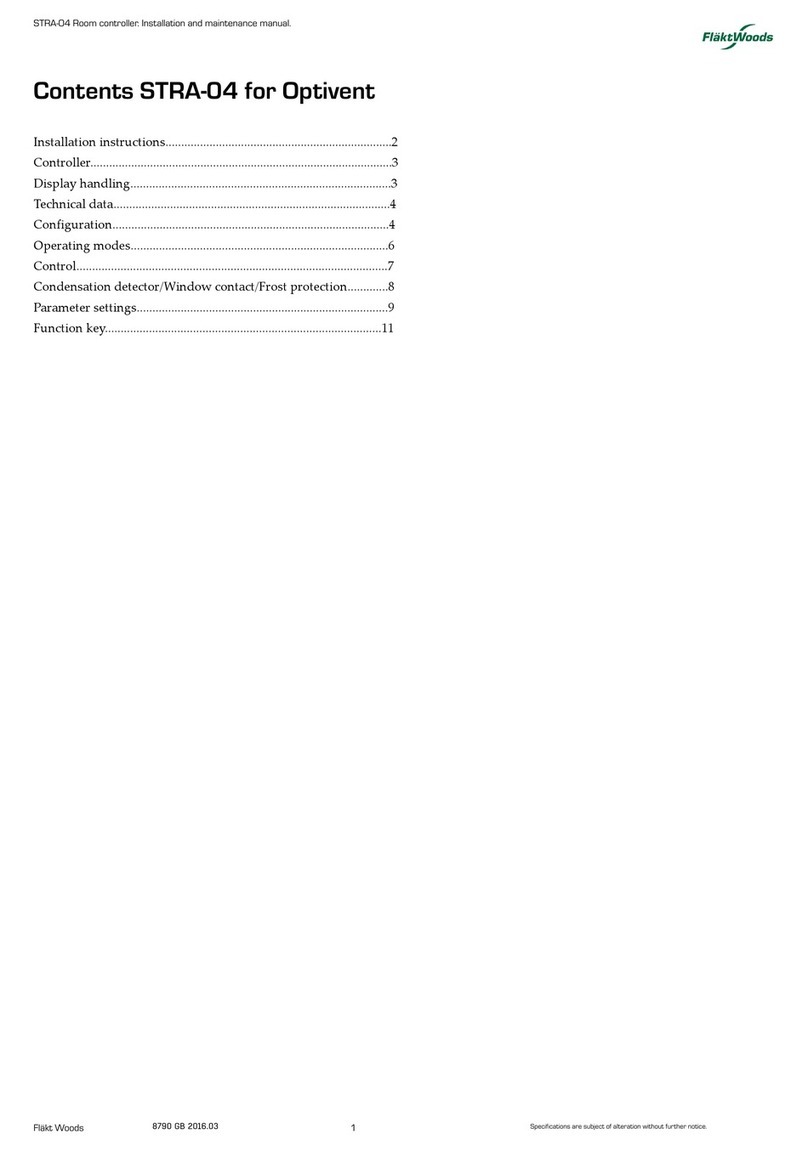
flakt woods
flakt woods STRA-04 Installation & maintenance manual
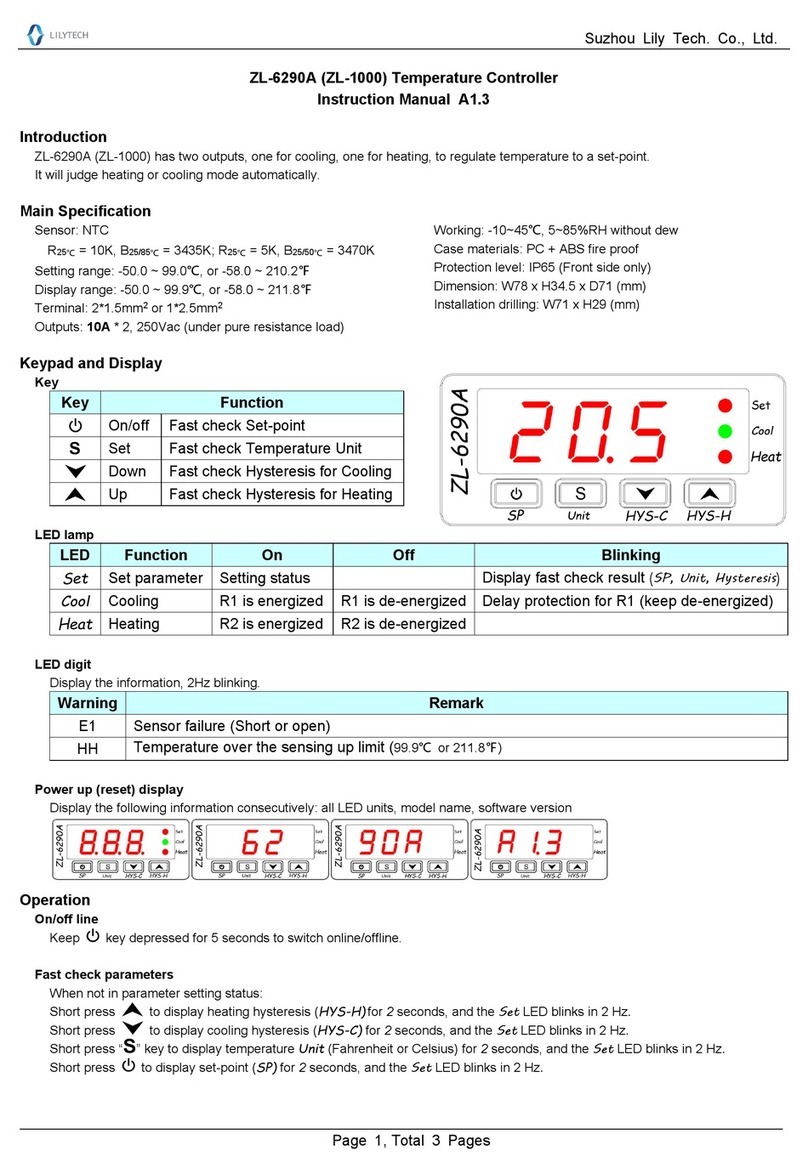
Lily Tech
Lily Tech ZL-1000 instruction manual
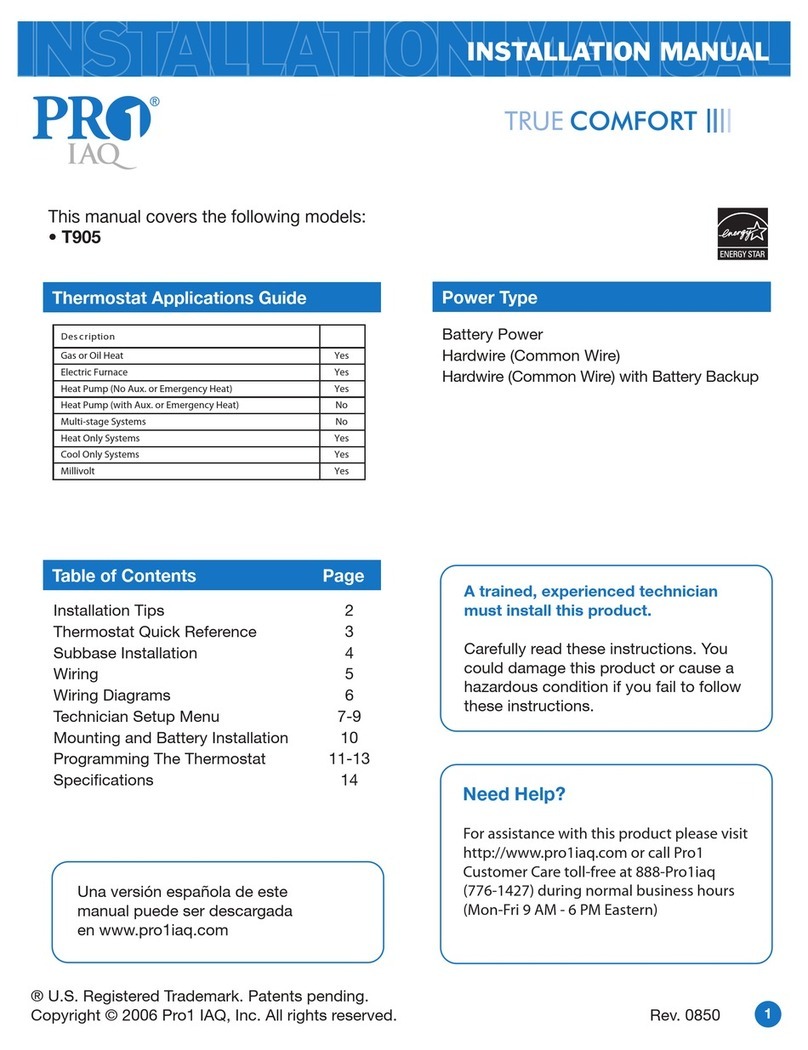
Pro 1 IAQ
Pro 1 IAQ True Comfort T905pro1 Installation & maintenance
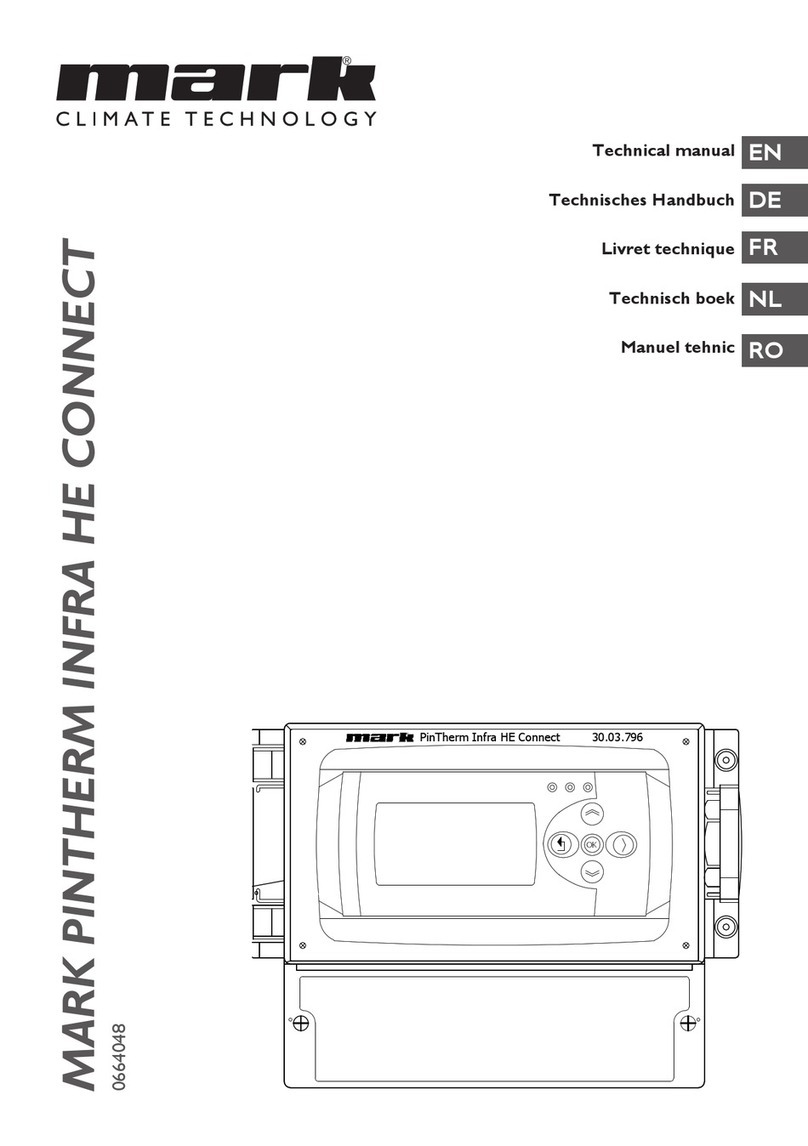
Mark
Mark PINTHERM INFRA HE CONNECT Technical manual
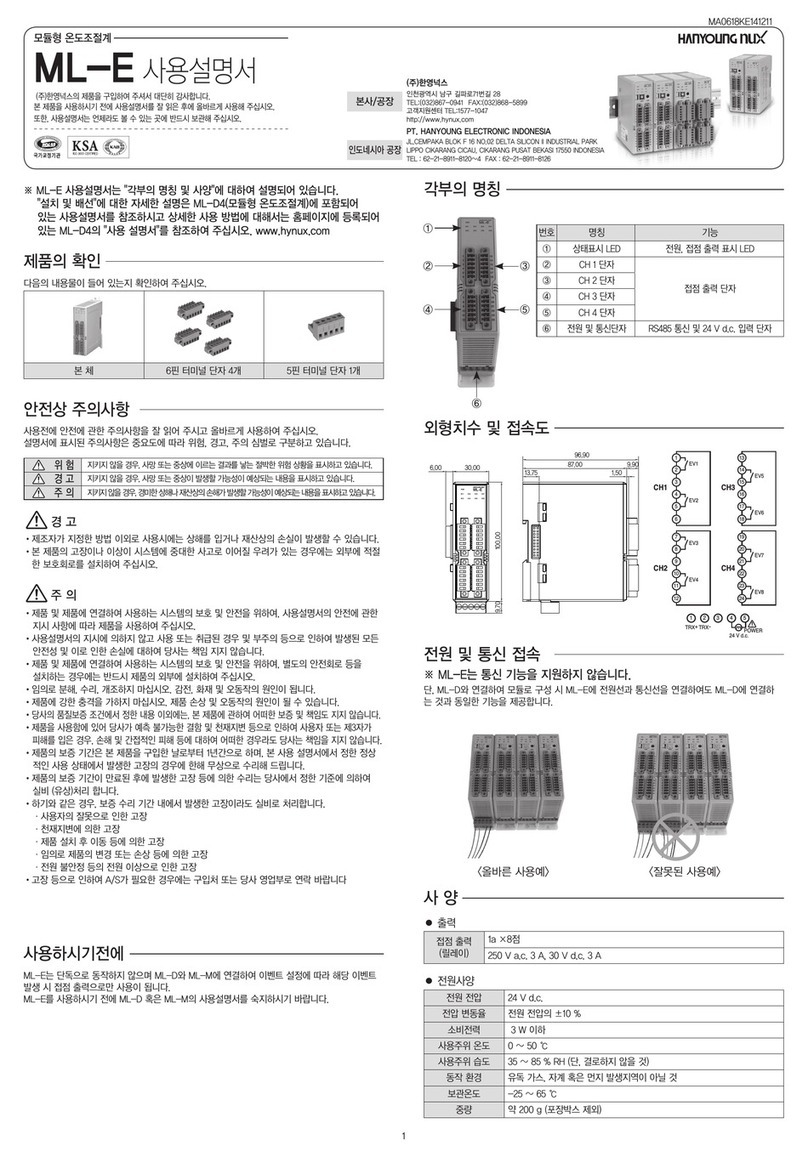
HANYOUNG NUX
HANYOUNG NUX ML-E instruction manual
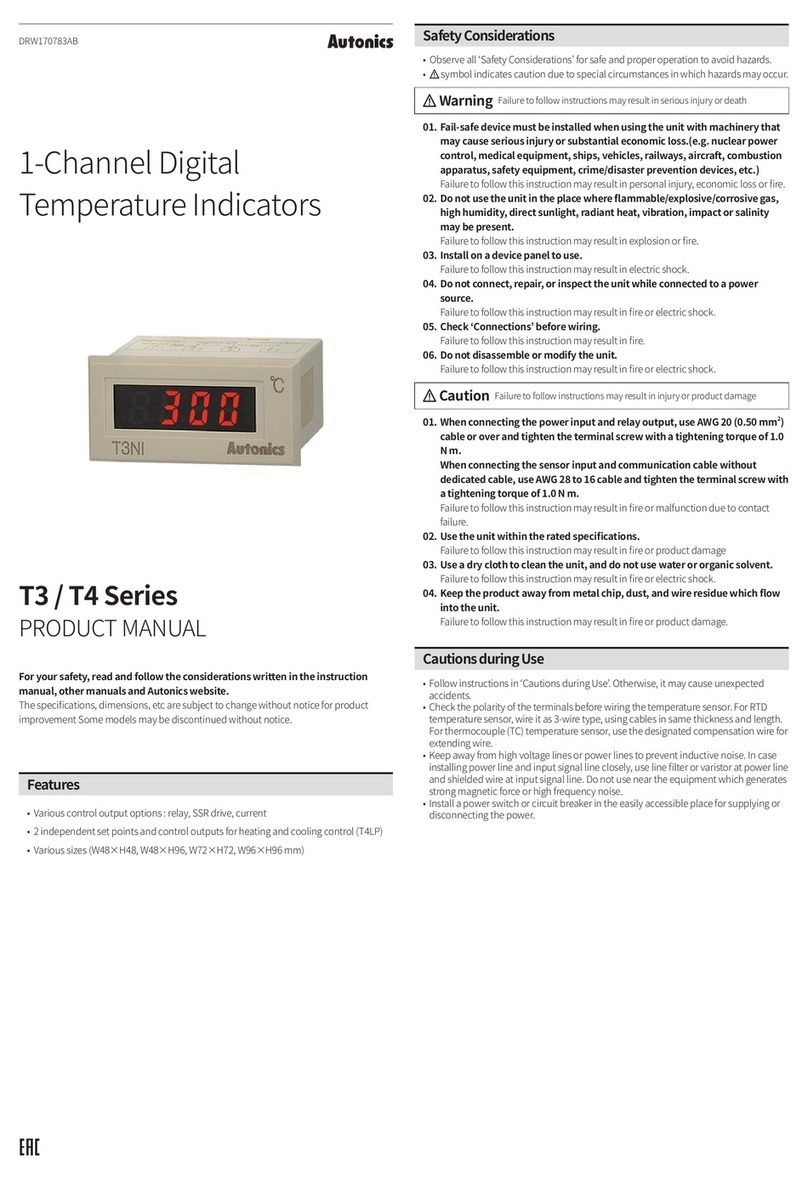
Autonics
Autonics T3 Series product manual
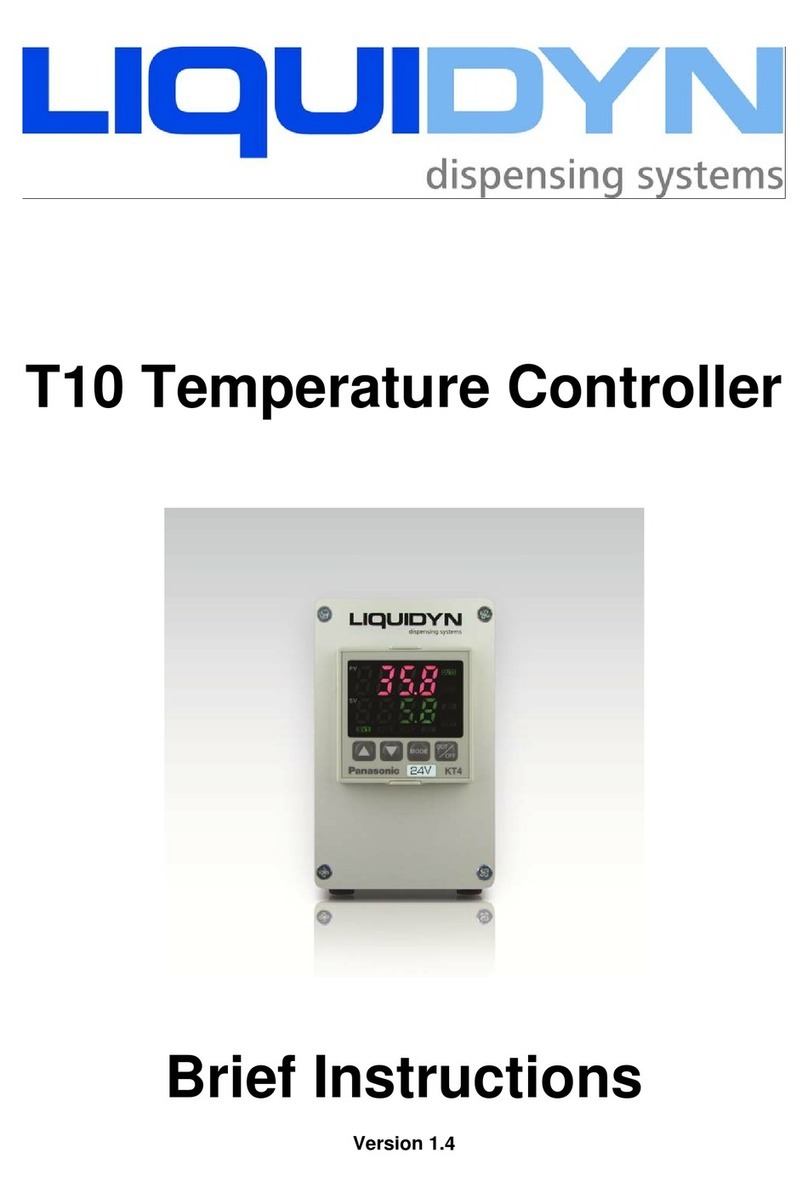
Liquidyn
Liquidyn T10 Brief instructions
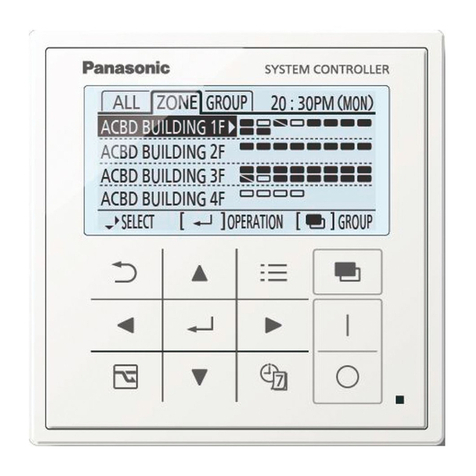
Panasonic
Panasonic CZ-64ESMC3 operating instructions
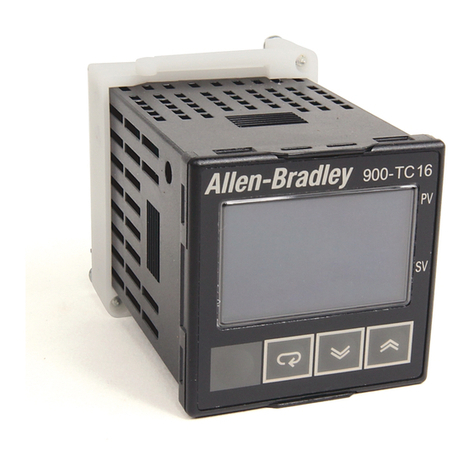
Rockwell Automation
Rockwell Automation Allen-Bradley 900-TC8 user manual
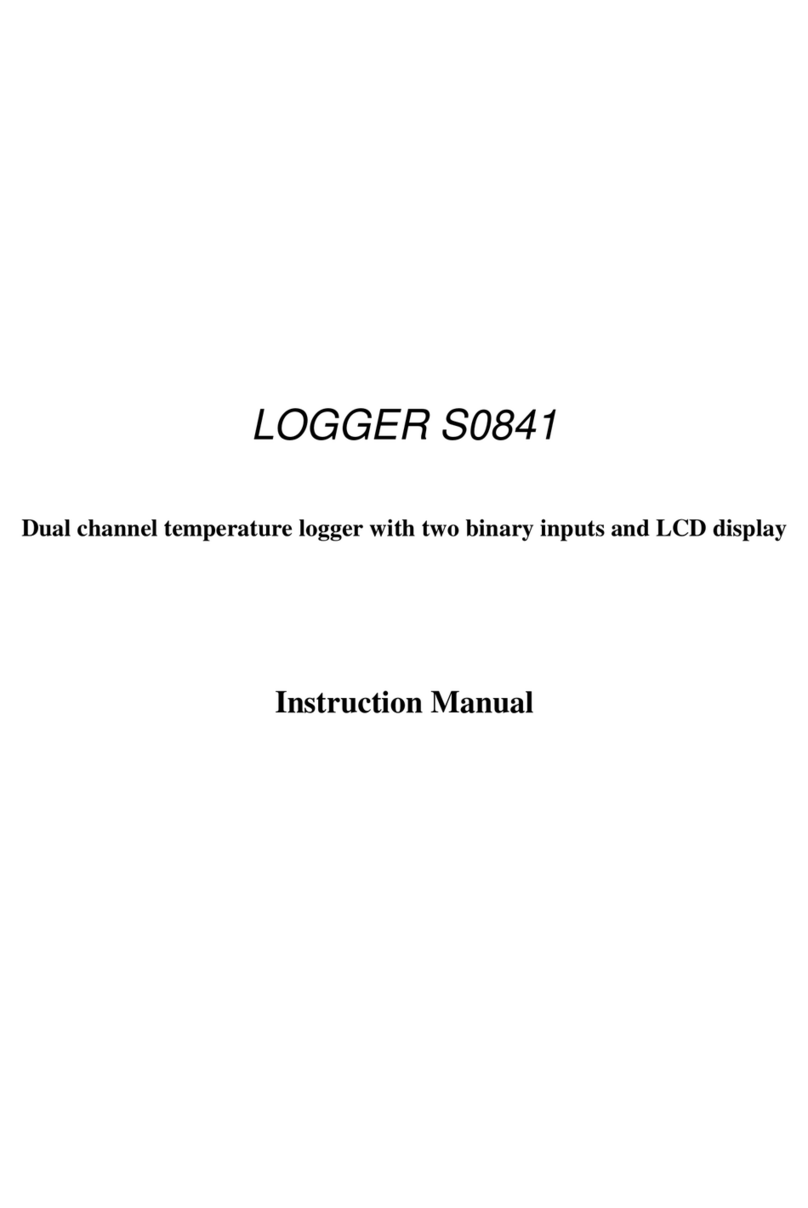
Comet
Comet S0841 instruction manual

Mitsubishi Electric
Mitsubishi Electric PAC-IF051B-E installation manual

natus
natus EMG Instructions for use
